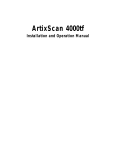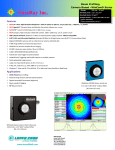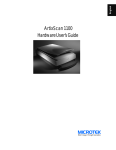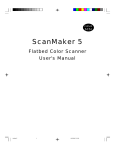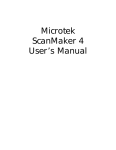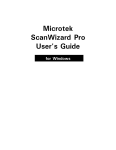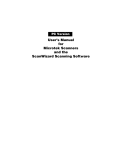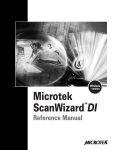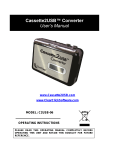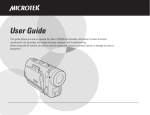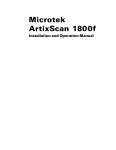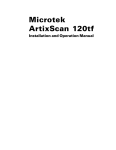Download Microtek ArtixScan 4500t Specifications
Transcript
Microtek ArtixScan 4500t INSTALLATION AND OPERATION MANUAL English Copyright 2000 by Microtek International, Inc. All rights reserved. Trademarks Microtek™, Artix™, ScanWizard Pro™, and ArtixScan™ are trademarks of Microtek International Inc. Windows® is a registered trademark of Microsoft Corporation. Other product or company names are trademarks of registered trademarks of their respective holders. Important Documents you scan may be protected under copyright law. The unauthorized use of such documents could be a violation of the rights of the copyright holder. Microtek bears no responsibility for the unauthorized use of copyrighted materials. Doc. No. I49-002910, A June 2000 Microtek Lab, Inc. 3715 Doolittle Drive, Redondo Beach, CA 90278-1226 Sales: 800-654-4160 Internet: http://www.microtekusa.com Tech Support: http://www.support.microtek.com Artix Japan Corporation FORO M Bldg. 5F, 2-1-18 Iwamotocho Chiyoda-ku, Tokyo 101-0032 Japan Tel: +81-3-5823-1555 Fax: +81-3-5823-1556 Internet: http://www.artixjapan.co.jp Microtek Europe BV Max Euwelaan 68 NL - 3062 MA Rotterdam The Netherlands Tel: 31-10-242-5688 Fax: 31-10-242-5699 Internet: http://www.microtek.nl Microtek Computer Asia Pte. Ltd. No. 160, Paya Lebar Road, 05-04, Orion Industry Building, 409022 Singapore Tel: 65 747 7851 Fax: 65 747 7852 Internet: http://www.microtek.com.sg Adara International, Inc. 8F, No. 220 Ta Tung Road, Section 3 Hsi Chih County, Taipei, Taiwan, R.O.C Tel: 02-2647-1488 Fax: 02-2647-1422 Internet: http://www.adara.com.tw Shanghai Zhong Jing Computers Co., Ltd. 1F, Building 35, No. 680, Guiping Road, Shanghai 200233, P.R.C. Tel: 86-21-64856614, 64853358 Fax: 86-21-64859686, 64859692 Internet: http://www.microtek.com.cn Microtek International Inc. 6, Industry East Road 3 Science Based Industrial Park Hsinchu 30077, Taiwan, R.O.C. Tel: 886-3-5772155 Fax: 886-3-5772598 Internet: http://www.microtek.com Federal Communications Commission Interference Statement This equipment has been tested and found to comply with the limits for a Class B digital device, pursuant to Part 15 of the FCC rules. These limits are designed to provide reasonable protection against harmful interference in a residential installation. This equipment generates, uses and can radiate radio frequency energy and, if not installed and used in accordance with the instructions, may cause harmful interference to radio communications. However, there is no guarantee that interference will not occur in a particular installation. If this equipment does cause harmful interference to radio or television reception, which can be determined by turning the equipment off and on, the user is encouraged to try to correct the interference by one or more of the following measures: • • • • Reorient or relocate the receiving antenna. Increase the separation between the equipment and receiver. Connect the equipment into an outlet on a circuit different from that to which the receiver is connected. Consult the dealer or an experienced radio/TV technician for help. FCC Caution Caution: To assure continued compliance, (example - use only shielded interface cables when connecting to computer or peripheral devices). Any changes or modifications not expressly approved by the party responsible for compliance could void the user’s authority to operate this equipment. This device complies with Part 15 of the FCC Rules. Operation is subject to the following two conditions: (1) This device may not cause harmful interference, and (2) this device must accept any interference received, including interference that may cause undesired operation. Responsible Party: Telephone No: Loi Han 3715 Doolittle Drive Redondo Beach, CA 90278-1226 U.S.A. 1-310-297-5000 Trade Name ArtixScan 4500t Model Number MTS-4500 Tested to Comply With FCC Standards FOR HOME OR OFFICE USE Federal Communications Commission Interference Statement This equipment (Model: MTS-4500) has been tested and found to comply with the limits for a Class B digital device, pursuant to Part 15 of the FCC Rules. These limits are designed to provide reasonable protection against harmful interference in a residential installation. This equipment generates, uses and can radiate radio frequency energy and, if not installed and used in accordance with the instructions, may cause harmful interference to radio communications. However, there is no guarantee that interference will not occur in a particular installation. If this equipment does cause harmful interference to radio or television reception, which can be determined by turning the equipment off and on, the user is encouraged to try to correct the interference by one or more of the following measures: • • • • Reorient or relocate the receiving antenna. Increase the separation between the equipment and receiver. Connect the equipment into an outlet on a circuit different from that to which the receiver is connected. Consult the dealer or an experienced radio/TV technician for help. Note: 1) A shielded of SCSI interface cable with ferrite core installed on the scanner connector end must be used with this equipment. 2) AC adapter with ferrite core installed on the scanner connector end must be used with this equipment. Caution: Changes or modifications not expressly approved by the manufacturer responsible for compliance could void the user's authority to operate the equipment. ii English Contents 1. Introduction .......................................................................................................................... 1 Specifications ..................................................................................................... 1 General Requirements ........................................................................................ 2 Minimum Macintosh requirements ............................................................... 2 Minimum PC requirements ........................................................................... 2 2. Before you begin .................................................................................................................. 3 Unpacking ......................................................................................................... 3 Front View ................................................................................................... 4 Back View .................................................................................................... 4 Checking the SCSI ID .......................................................................................... 5 Power up ........................................................................................................... 6 A. Connecting the scanner to the power source ............................................ 6 B. Performing the power-on self-test ............................................................. 6 3. Installation ............................................................................................................................ 8 Step 1: Installing SCSI card .................................................................................. 8 For the Macintosh: Install SCSI card if the Mac has no built-in SCSI interface .......................... 8 For the PC: Install SCSI card under Windows 95, 98, 2000 and NT ............................. 8 Checking the interface card driver under Windows 95/98/2000 ............... 9 Installing the interface card driver under Windows NT ............................. 9 Step 2: Connecting your scanner ...................................................................... 10 Step 3: Using terminator ................................................................................... 11 Step 4: Installing the software ........................................................................... 11 For the Macintosh ...................................................................................... 11 For the PC .................................................................................................. 11 4. Scanner Transparency Accessories ............................................................................. 12 How to use your scanner transparency accessories ........................................... 13 Step 1: Placing the transparent film ................................................................... 13 For non-standard-sized transparent film ..................................................... 13 Using the Glass Holder ........................................................................... 13 For standard-sized transparent film ............................................................ 14 Using the Main Holder ........................................................................... 14 For 4" x 5" film ...................................................................................... 14 For 6 x 6 cm or 6 x 7 cm film .................................................................. 14 For 35mm mounted and unmounted slides ............................................ 15 Using the 4-in-1 Slide Holder .................................................................. 16 Step 2: Insert Film Holder into scanner ............................................................. 17 iii English 5. How to calibrate your scanner ....................................................................................... 18 Introduction ..................................................................................................... 18 Calibration target ............................................................................................. 18 Taking care of the target ................................................................................... 18 Installing the Scanner ICC Profiler .................................................................... 19 A. For the Macintosh .................................................................................. 19 B. For Windows 95 / 98 / 2000 / NT 4.0 ..................................................... 19 Placing the color target ..................................................................................... 19 Starting Calibration .......................................................................................... 20 Scanning the target image ................................................................................. 21 Aligning the target registration marks ............................................................... 22 A. Aligning the upper-left registration mark ................................................. 22 B. Aligning the upper-right registration mark ............................................... 22 C. Aligning the bottom-right registration mark ............................................ 22 Creating a profile .............................................................................................. 23 Reference Section for Macintosh ...................................................................... 24 A. Menu commands .................................................................................... 24 B. The Main Window .................................................................................. 25 C. The Calibration Window: Preview and Scan ............................................ 26 D. The Calibration Window: Aligning targets and creating the profile .......... 26 Reference section for PC .................................................................................. 27 A. The Main Window .................................................................................. 27 B. The Calibration Window: Preview and Scan ............................................ 29 C. The Calibration Window: Aligning targets and creating the profile ........... 29 6. Troubleshooting ................................................................................................................. 30 Introduction ..................................................................................................... 30 Questions and Answers for Windows 95/98/2000 ............................................ 30 Questions and Answers for Windows NT 4.0 .................................................... 32 Questions and Answers for Macintosh G3/G4 .................................................. 34 iv English 1 Introduction Congratulations on your purchase of the ArtixScan™ 4500t multi-format film scanner! This 42-bit, high resolution scanner features a dynamic range of 3.9 resulting in scans that include incredible detail in shadow and highlight areas from film originals. This scanner has been specifically engineered for photographers and other graphic arts professionals who demand scanned images that are accurate in color, sharpness, detail and clarity with their original film. This manual will help you in the installation and operation of your scanner. Specifications Type Desktop, 1-pass film scanner Image Sensor Tri-linear 10,000 element CCD Interpolation Resolution 10,000 dpi Optical Resolution 2,500 dpi Sample Depth 14 bits per color Dynamic Range 3.9 Scanning Media 35mm to 4" x 5" positive or negative, mounted and unmounted transparencies Interface SCSI-2 Lamp Source Cold Cathode Lamp Accessories 4" x 5" (10 x 12.7 cm) 2.4" x 2.8" (6 x 7 cm) 2.4" x 2.4" (6 x 6 cm) Dimensions 356 mm (W) x 180 mm (H) x 530 mm (L) Net Weight 9.2 kg Power Consumption 40W at 115VAC, 66 Hz Certifications CSA, TUV, FCC class B, CF ArtixScan 4500t Installation and Operation Manual 1 English General Requirements Before unpacking your scanner, make sure that the site where the scanner will be installed is big enough to allow for easier operation. • Make sure that the operating environment for the scanner is free of dust and other contaminants. • Allow adequate ventilation space (no less than 2 inches) around the scanner. • Place the scanner on a flat, stable surface that is not subject to vibration. • Make sure that the scanning surface will not be exposed to direct sunlight or other sources of bright light. • Avoid placing the scanner close to sources of extreme temperature. • Try to ensure the scanner is situated in its ideal operating temperature range -- between 60° and 104°F (10°C and 40°C). • Keep the relative humidity in the scanner operating area between 10% and 85%. • Avoid connecting the scanner to a power source that might experience power surges. • Avoid positioning the scanner in the path of heavy traffic where it may get bumped. • Your scanner should be placed within 3 feet of the computer. Use the SCSI cable that came with your scanner. Once the scanner has been placed in a suitable location and is ready to be connected to the host computer, it is time to proceed to installing the necessary hardware and software components for the scanner. Minimum Macintosh requirements • Apple Power Mac with PCI bus (150 MHz) • Apple Macintosh system software version 8.5 or higher • CD-ROM drive • 64MB of available RAM (128 MB recommended) • Color monitor at least 17" with 24-bit color display ability Minimum PC requirements • Pentiums, or compatibles with a CD-ROM drive • 64MB RAM for full version of Photoshop (128 MB recommended) • Microsoft Windows 95/98/NT4/2000 • VGA color monitor; color display card; laser printer (recommended). Photoshop requires a monitor and display card capable of displaying at least 256 colors. • Basic knowledge of Windows, and how to install an interface card inside the PC. 2 ArtixScan 4500t Installation and Operation Manual English 2 Before you begin Unpacking Remove the scanner from the box, and save the box and packing materials in case you need to ship the scanner again. Upon opening the scanner box, you will see a Packing List that lists both hardware and software components of your scanner package, as well as the part numbers for those components. If any component is missing, call Microtek Sales and provide information on the missing component and part number. Please be ready to provide the scanner's serial number and your proof of purchase as well. Keep the Packing List for your reference in case you need to order a component in the future. Note: If you need to ship back the scanner for any repairs, the scanner must be packed in the original box in which it came. Otherwise, Microtek will not be responsible for any damage that may be sustained during shipping to or from Microtek. You may be charged for a new box. SCSI cable Power cord ArtixScan 4500t TH IS D IS SI TH E E P D U SI U P Includes Document Box CK LO CK LO UN Includes Holder Box Main Holder (Metal) Installation & Operation Guide 6 x 6 cm 35 mm Film Mount Film Mount & Slide Spacer Software User’s Guide 6 x 7 cm 4 in 1 35mm Glass Holder Film Mount Slide Holder (Plastic) & Film Mount Software QR Driver CD ArtixScan 4500t Installation and Operation Manual 3 English Front View Film Holder Insert Slot Back View SCSI ID Switch CAUTION Fan Power Switch 6 DC Power Inlet SCSI Terminator Switch 4 ArtixScan 4500t Installation and Operation Manual 25-pin SCSI Connector 50-pin SCSI Connector English Checking the SCSI ID A SCSI ID is a number assigned to each SCSI device in your daisy chain to differentiate the devices from one another. The SCSI ID for Microtek scanners is set at default to 6. You won't need to change the SCSI ID on your scanner unless another SCSI device on your system (such as a ZIP drive or CD-ROM drive) is using the same number. CAUTION 6 6 + To set the SCSI ID number: Locate the SCSI ID selector, which is on the back panel. To change the SCSI ID, press the push-button selector. Notes on SCSI ID numbers • Each SCSI device must have a unique SCSI ID number. • Valid SCSI ID numbers are 0 to 6. Do not use SCSI ID #7, which is used to carry a selftest for the scanner and make the carriage move back and forth. SCSI ID #8 and #9 are also not used. ArtixScan 4500t Installation and Operation Manual 5 English Powering up A. Connecting the scanner to the power source Connect the scanner to a voltage source directly by using the supplied power cord. Make sure that the power outlet will not be overloaded when the scanner is turned on, and ensure that other devices requiring significant power are not plugged into the same outlet. Ideally, no other devices should share the scanner’s power source. B. Performing the power-on self-test The power-on test is a quick self-checking mechanism that the scanner carries out after you turn it on. This is what happens after the scanner is turned on: 1. Close the Front Cover. Note Note: This step is a must. Without closing the Front Cover, your scanner stays at the Not Ready state. Front Cover 6 ArtixScan 4500t Installation and Operation Manual 4. The fluorescent lamp inside the scanner should be on too by this time. The lamp should never go off while the scanner is on. ArtixScan 4500t Installation and Operation Manual 7 English 2. Switch the power on. The POWER indicator on the front panel of the scanner lights up. 3. The READY indicator beside the POWER indicator flashes briefly. After a 30-second warm-up period, the scanner carries out a self-test, with the scanner carriage moving back and forth about a half-inch. If no problems are detected, the READY indicator stays lit. English 3 Installation The ArtixScan 4500t installation procedure includes 4 steps: Step 1: Installing SCSI card Step 2: Connecting your scanner Step 3: Using terminator Step 4: Installing software Step 1: Installing SCSI card If your system is SCSI-ready, go to “Step 2: Connecting your scanner” directly to connect your computer. If your system is not the SCSI-ready, you will need to install a SCSI card. For the Macintosh: Install SCSI card if the Mac has no built-in SCSI interface 1. Shut down your Macintosh computer and peripherals, unplug the power cord. Next, open your computer. 2. Look for an available PCI card slot (typically white or ivory) in your computer. Remove the slot cover, and insert the PCI SCSI card into the slot. Push the card in to make sure it is seated all the way in the slot. This is important, as an improper card connection will make you unable to use your scanner, and you will then have to remove the computer case and reinsert the card. C SI SC ard SCSI Card 3. Close the computer, then plug the power cord back in. For the PC: Install SCSI card under Windows 95, 98, 2000 and NT 1. Turn off your PC and peripherals, then unplug the power cord. Next, remove the cover from your computer. 2. Before handling the interface card, touch a metal frame (such as your computer casing) to discharge any static electricity buildup in your body. 8 ArtixScan 4500t Installation and Operation Manual English 3. Look for an available PCI card slot in your computer, then insert the PCI SCSI card (such as the Adaptec AVA-2903E) into the slot. Push the card in to make sure it is seated all the way in the slot, then put the screw back into the bracket. SC SI c ard Proper card connection is important, as an improper card connection will make you unable to use your scanner, and you will then have to remove the computer case and start the process of card insertion all over again. 4. Replace the cover of the computer, then plug the power cord back in. 5. Turn your PC back on. Check the interface card driver under Windows 95/98/2000 With the new SCSI card installed in your computer, when Windows starts, the card is detected and the driver is automatically installed. You may be asked to insert your Windows CD-ROM. Do so, and follow the steps below to check your card status. 1. Double-click on the System icon in Control Panel and select Device Manager from the top. 2. Double-click on SCSI controllers to display the screen below. If you are using Adaptec SCSI card, the string “Adaptec 7850 PCI SCSI Controller” indicates that the driver is installed. The message “Adaptec AIC-7850 PCI SCSI Controller” displays indicates that the driver is installed and the interface card works properly. Install the interface card driver under Windows NT 1. Start your computer, and log in as Administrator Administrator. Note: You must be logged in as Administrator in order to install the scanner software components and use the scanner. 2. In Windows, go to Start, Settings Settings, then double-click on Control Panel Panel, and doubleclick on the SCSI Adapters icon. 3. Select the Drivers tab in the SCSI Controllers dialog box, and click on the Add button. 4. From the list of drivers that appear, select Adaptec for manufacturers on the left (assuming that you are using Adaptec SCSI card), and Adaptec AIC-78xx PCI SCSI Contr oller on the right. You may be asked to insert your Windows NT CD-ROM at this Controller point; do so. 5. You will be asked to restart your computer. Click Yes to do so. Note: If you cannot successfully install the SCSI card, refer to “Chapter 6: Troubleshooting”. ArtixScan 4500t Installation and Operation Manual 9 English Step 2: Connecting your scanner When the SCSI card is installed, follow the steps below: 1. Shut down your computer. 2. Connect the scanner to your computer, using the SCSI cable provided in the scanner package. Mac (G3/G4 Model) Mac (PowerMac Model) PC 3. Plug the power cord to the power connector at the back panel of the scanner, and plug the other end of the power cord to your AC power source or wall outlet. 4. Turn on your scanner and wait for the lights on the front panel to stop blinking and stay on steady. 5. Power up your computer. 10 ArtixScan 4500t Installation and Operation Manual English Step 3: Using terminator If you are connecting the scanner in a daisy chain to other SCSI devices (such as a CDROM drive), take note of the following: 1. If the scanner is the last device on the SCSI chain, set the internal terminator switch on the back of the scanner to the “ON” position. There is no need to install an external terminator on any of the other SCSI devices on the chain. ON OFF 2. If the scanner is not the last device on the SCSI chain: • Make sure the internal terminator switch located at the back of the scanner is set to the “OFF” position. • Make sure the last device on the SCSI chain is terminated. Step 4: Installing the software For the Macintosh Insert the ScanWizard Pro CD-ROM into your CD-ROM drive. When the CD-ROM icon appears on your Macintosh desktop, open the software folders individually, then doubleclick the Installer icon on each folder to install the respective programs one at a time. For the PC Insert the ScanWizard Pro CD-ROM into your CD-ROM drive; the Scanner Software installer should come up automatically. Note: If the Scanner Software is not automatically displayed, click Star Startt, select Run and type d:\cdsetup (where d: is your CD-ROM drive). ArtixScan 4500t Installation and Operation Manual 11 See illustrations below and check to see that you have all of the items. Purpose Glass Holder (Plastic) To scan non-standard-sized film up to 3.8" x 4.8" Main Holder (Metal) To scan standard sized film (Maximum 3.8" x 4.8") • 6 x 6 cm Film Mount To hold 6 x 6 cm film • 6 x 7 cm Film Mount To hold 6 x 7 cm film • 35 mm Slide Mount To hold 35 x 35 mm film • 35 mm Slide Spacer (metal) To raise the thickness of mounted 35 mm slides so that slides can fit on 35 mm Slide Mount 4-in-1 35 mm Slide Holder To scan 35 mm slides Vinyl Strip To secure film to the Glass Holder Magnetic strip To secure film to the Main Holder IS TH Item E SID P U CK LO N U CK LO English 4 Scanner Transparency Accessories TH IS SID E U P 12 ArtixScan 4500t Installation and Operation Manual English How to use your scanner transparency accessories There are three ways to scan transparent films: • By using the Glass Holder, which is used to scan non-standard-sized transparent film. • By using the Main Holder which is used together with the individual film mount to scan a particular type of standard-sized transparent film, such as individual 4" x 5", 6 x 6 cm, 6 x 7 cm, or 35 mm film mount. • By using the 4-in-1 35 mm Slide Holder, which is used together with 4-in-1 35 mm slide mount. Step 1: Placing the transparent film For non-standard-sized transparent film Using the Glass Holder 1 Place film on the Glass Holder (on the surface that prints “This Side Up”), with the film upright and facing up. ABC This Side Up 2 Use the Vinyl strips to tape the IS SI D E U P ABC TH IS D SI E U P Important Important: Make sure the film is taped securely to the glass. Otherwise, the film may fall out when you insert the Glass Holder into the scanner, and you will not be able to retrieve the film. TH film to the glass to secure it in place. Note Note: For best results, the area around the film should be covered so that no light can go through the glass around the sides of the film. • The maximum scanning area is 3.8" x 4.8", so trim a piece of black paper to 3.8" x 4.8". • Cut out a hole in the paper and make the cutout big enough so that the film underneath shows through. The black paper should then cover the perimeter of ArtixScan 4500t Installation and Operation Manual 13 English the film. For standard-sized transparent film LOCK Using the Main Holder UNLOCK LO C K CK LO N the Main Holder on an even surface, turn the locker to the “Unlock” position, then open it. U Before placing the standard-sized transparent film, place Guide pin For 4" x 5" film Film is held in place by guide pins 1 Place the film upright and O C K CK L Unlock LO N Lock LOCK LOCK Be careful that the guide pins do not puncture the film when you place the film inside the film holder. U facing up inside the Main Holder, and rest the upper and left edges against the two guide pins for positioning. UNLOCK UNLOCK 2 Close the Main Holder. For 6 x 6 cm or 6 x 7 cm film 3 Turn the locker to the “Lock” 1 position. Place the film to be scanned inside the film mount (6 x 6 cm or 6 x 7cm size), with the film facing up. 2 Use the Magnetic strips to Magnetic strips secure the film to the film mounts and position the strips along the edge, making sure that the area to be scanned is not covered by the strips. 3 Place the mounted film in the Main Holder, and rest the upper and left edges against the two guide pins for positioning. Be careful that the guide pins do not puncture the film when you place the film inside the film holder. Guide pins Mounted film 4 Close the Main Holder. N O C K ArtixScan 4500t Installation and Operation Manual CK L position. 14 LO U 5 Turn the locker to the “Lock” English For 35mm mounted and unmounted slides 1 Do one of the following: A Mounted slide A. To scan thick mounted slides Place the mounted slide in film mount. Secure the film under the clips of the film mount to lock the slide in place. Film mount B. To scan thin mounted slides Place the metal slide spacer beneath the clips of film mount, then push the mounted slide under the clips to lock the slide in place. 2 Place film mount inside the Main Holder, and rest the upper and left edges of the film adapter against the two guide pins for positioning. Be careful that the guide pins do not puncture the film when you place the film inside the film holder. Mounted slide B AB Film mount Metal slide spacer 3 Close the Main Holder. Then turn the locker to the “Lock” position. Guide pins Film mount N L O C K CK LO U ArtixScan 4500t Installation and Operation Manual 15 English Using the 4-in-1 Slide Holder 1 Place the 4-in-1 Slide Holder on an even surface, then open the film holder. IS TH E SID P U 2 Place the slides to be scanned inside the slide mount, with the film facing up. 3 Close the slide holder. IS TH E D SI P U 16 ArtixScan 4500t Installation and Operation Manual English Step 2: Inserting Film Holder into scanner 1 Open the Front Cover. 2 Insert the Glass Holder (with films loaded properly) into the ArtixScan 4500t. 3 Close the front cover of the IS TH E SID UP ArtixScan 4500t. You are now ready to scan. Please refer to ScanWizard Pro User’s Manual for operation. Warning: To scan images, you must close the front cover. Otherwise the scanner will stay at the Not Ready state. ArtixScan 4500t Installation and Operation Manual 17 English 5 How to calibrate your scanner Introduction The Scanner ICC Profiler is a scanner calibration and profiling utility program designed exclusively for use with Microtek scanners, including the ArtixScan 4500t. The Scanner ICC Profiler lets you calibrate the color attributes of your scanner and lets you create an ICC color profile customized and tailored especially for your scanner. Why do you need the Scanner ICC Profiler? Every Microtek Artix scanner includes a factory-set ICC color profile for use with the scanner controller program — in this case, ScanWizard Pro. This factory-set profile delivers high color quality in general. But scanners, like any high quality imaging device, interpret colors differently, resulting in subtle variations and differences in color imaging. In addition, individual scanners of the same model may also perform differently due to other factors, such as aging of the scanner lamp or ambient temperature fluctuations. With the Scanner ICC Profiler, such color variations and differences can be minimized or eliminated, as the program calibrates the scanner and compensates for subtle color deviations. The customized color profile resulting from the use of the Scanner ICC Profiler, in effect, delivers more accurate color and contributes to overall improved image quality. To keep the colors in your scanner consistent over time, it’s recommended that you use the Scanner ICC Profiler regularly. Professional photographers or others who require extremely precise color may wish to use the Profiler every time before they use their scanner, but for most general usage, calibrating twice a month should be sufficient. Calibration target Your Scanner ICC Profiler kit includes industry-standard Kodak Q-60E1 IT8 color target for calibration. Calibrating the scanner ensures color accuracy when you scan transparent media such as slides and filmstrips. Taking care of the target The calibration target is very delicate and must be handled carefully. Make sure you follow these rules in caring for the target. • Gently take the target out of its protective sleeve. • Do not touch the target image with your fingers or with any other object. • When not in use, keep the target out of light — even interior lighting. 18 ArtixScan 4500t Installation and Operation Manual English • Always return the target to its protective sleeve immediately after use. • Store the target away from light in a cool, dry place, since long exposure to heat and light can change the colors on the target. Installing the Scanner ICC Profiler Note: The Scanner ICC Profiler program should have been installed at the time you performed software installation procedures (discussed earlier in the manual). If for some reason you have not installed the Scanner ICC Profiler, follow the steps below to install the program. A. For the Macintosh Before installing the Scanner ICC Profiler, you should have ScanWizard Pro and the Kodak CMS programs installed on your computer. To install the Scanner ICC Profiler program: Insert the Artix CD into your CD-ROM drive. Open the ICC Profiler folder, then double-click the Installer icon to install the program. B. For Windows 95/98/2000/NT 4.0 Before installing the Scanner ICC Profiler, you should have ScanWizard Pro and the Kodak CMS programs installed on your computer. To install the Scanner ICC Profiler program: Insert the Artix CD into your CD-ROM drive. When the Software Installer screen appears, click on the “Install” option for the Scanner ICC Profiler program, then follow the on-screen instructions until the program finishes installing. Placing the color target With the correct alignment (as shown in the figure below), place the 4" x 5" target in the metal Main Holder, then place it into the scanner. For further information on how to place the target, refer to Chapter 4, page 14. K C LO K C LO N U ArtixScan 4500t Installation and Operation Manual 19 English Starting Calibration 1. Turn on your scanner and let it warm up for about five minutes. 2. Place the target inside the scanner. 3. Launch the Scanner ICC Profiler calibration utility. The main menu below appears. A. Choose the media type. Select Positive Film to calibrate. B. Select the target type that matches your target type and date code. You can verify this information by looking at the bottom of the target for the date code and the target type information. Date code and target type information Note: If you are unable to select the target type with date code that matches with the target you are using, find the Target Profile CD that came with your scanner. In Macintosh, run Macsetup program; in Windows 95/98/2000/NT 4.0, run Winsetup.exe on the CD, then restart your computer, the target type with the date code is now available for selection. 20 ArtixScan 4500t Installation and Operation Manual English ofiling button. The calibration window will appear, and an initial C. Click on the Star Startt Pr Profiling preview is performed. Scanning the target image Following the Preview, a message appears informing you of the next step to be done. To select the target image, move the pointer (now a crossbar) to the preview image, and draw a frame enclosing the entire target image. When you release the mouse, a scan frame appears, which is the dotted marquee enclosing the target image. To resize the selection, move the cursor to any corner of the frame; the pointer is changed to a double-headed arrow. Hold down the mouse, drag to form a new selection, then release the mouse. When the target image is selected, click the Scan button to scan the target. ArtixScan 4500t Installation and Operation Manual 21 English Aligning the target registration marks A. Aligning the upper-left registration mark Move the cursor into the target image area; the pointer will change to a flipped L mark (“ ”). Align the cursor with the small upper-left registration mark. Upper left registration mark B. Aligning the upper-right registration mark After the upper left mark is aligned, the upper right part of the target image is displayed, and an instruction dialog box prompts you to align the upper right registration mark. Upper right registration mark Move the cursor into the target image area; the pointer will change to a normal L mark (“ ”). Align the cursor with the small upper-right registration mark. C. Aligning the bottom-right registration mark After the upper right mark is aligned, the lower right part of the target image is displayed, and an instruction dialog box prompts you to align the bottom right registration mark. Bottom-right registration mark Move the cursor into the target image area; the pointer will change to a vertically flipped L mark (“ ”). Align the cursor with the small bottom-right registration mark. 22 ArtixScan 4500t Installation and Operation Manual English Creating a profile Following the alignment of registration marks, an instruction dialog box appears, prompting you to click the Calibrate Profile button. Click the Calibrate Profile button. This only takes a few moments. When the process is finished, a Save Profile As dialog box appears, prompting you to input Profile Filename and Profile Description. Click OK OK, a custom scanner ICC profile is saved automatically to your hard disk. Exit the Scanner ICC Profiler now, and use the new scanner profile with ScanWizard Pro to scan excellent color images. Note: If the process fails, you will need to rescan the target image and repeat the calibration procedure described in the preceding pages. Make sure the registration marks are aligned properly, then click the Calibrate Profile button again to create your profile. ArtixScan 4500t Installation and Operation Manual 23 English Reference Section for Macintosh This section describes the features and commands of the Microtek Scanner ICC Profiler program. All features are covered in the Menu commands, the Main window, and the Calibration window. A. Menu commands 1. Apple Menu — About ICC Profiler: Choose the About ICC Profiler command from your Apple menu to display the splash screen for the Scanner ICC Profiler program. The screen includes the product logo and the software version number 2. Scanner Menu: The Scanner Menu lets you see information on your current scanner and your SCSI chain. a) Find Plug-in: This command lets you choose the correct ScanWizard Pro Plug-in driver for the ICC Profiler program (in case the Plug-in driver cannot be found). b) Get Current Scanner Info: This command provides information on the current scanner. A dialog box appears showing the scanner model in use, the SCSI ID number of the scanner, and the firmware version of the scanner. c) Scanner Probe: This command displays the SCSI devices on the SCSI chain, as well as the SCSI ID numbers of the individual devices. To use this command: 1. Choose the Get SCSI Chain Info command. 2. If your scanner does not show in the list, make sure it is connected and turned on, then click on the Probe button in the dialog box. • Choose the correct interface card in the card selection box. • Check the numbered box corresponding to the SCSI ID of your scanner. Click OK to close the dialog box 24 ArtixScan 4500t Installation and Operation Manual English B. The Main Window The Main window provides various features and a system menu, allowing you to control the calibration process. Controls: 1. Scanner Model: This option lets you select the scanner to be calibrated. 2. Media: This option lets you select the media type for calibration. If a particular media is not supported, that media will not appear on the list. 3. Target type: This option lets you select the Target Description File (TDF) that matches your Q-60E1 calibration target being used for calibration. Note: The Target Description File (TDF) contains colorimetric measurements of the target. Each target lot contains unique colorimetric data, and the Scanner ICC Profiler evaluates the scanned RGB data of the target and then matches it to the colorimetric data inside the TDF to create an ICC color profile — a characterization of how your scanner “sees” color. 4. Tonal Mapping: This option lets you select the way in which the tonal reproduction curve of the profile is controlled. • Normal: Slightly brightens the highlights but also darkens the shadows. Lighten: Brightens the highlights and also lightens the image overall. • Darken: Darkens the shadows without changing the highlights. • Reduce Contrast: Captures as much of the original as possible. Recommended for CMYK color separation. 5. Darken Shadow: This option lets you compensate for artifacts introduced by the scanner that indicate problems with the shadow portion of the image. You should enable this option if you wish to: • Minimize detail in the shadow areas of the image; • Make the shadow areas of an image darker; or • Reduce the appearance of noise in the shadow areas. 6. Start Profiling: This button starts the calibration process by displaying the calibration window and guides you through the process to create a customized scanner ICC profile. 7. Close: This button lets you close and exit the Scanner ICC Profiler. 8. Help: This button displays the Help window. ArtixScan 4500t Installation and Operation Manual 25 English C. The Calibration Window: Preview and Scan 1. Preview: The Preview button performs a preliminary scan of the target, displaying the entire target image in the calibration window. 2. Scan: The Scan button scans the target image and prepares the scanner for the important succeeding steps of aligning the registration marks and creation of the profile. D. The Calibration Window: Aligning targets and creating the profile 1. Create Profile: This button starts the actual calibration process in which a custom scanner ICC profile is created for the scanner. This button is grayed out until you have performed the required alignment of the three registration marks on the target. 2. Previous Mark: This button lets you go back one step to align the previous registration mark. 3. Next Mark: This button lets you go forward one step to align the next registration mark. 4. Go to Step 1: This button takes you back to the preview image screen so that you can rescan the target image and restart the calibration process. 5. Show Patches: This option lets you check the sampling area of all the color patches. When aligned properly, the sampling area appears as a green square in the center of most patches. If any areas fall outside a patch, realign the registration marks by clicking the “Previous Mark” and “Next Mark” buttons, and then reselecting the registration marks until the sampling areas are centered. 6. Close: This button lets you return to the main screen 26 ArtixScan 4500t Installation and Operation Manual English Reference section for PC This section describes the features and commands of the Microtek Scanner ICC Profiler program. All features are covered in the Main window and Calibration window. A. The Main Window The Main window provides various features and a system menu, allowing you to control the calibration process. Controls: 1. Scanner Model: This option lets you select the scanner to be calibrated. 2. Media: This option lets you select the media type for calibration. If a particular media is not supported, that media will not appear on the list. 3. Target type: This option lets you select the Target Description File (TDF) that matches your Q-60E1 calibration target being used for calibration. Note: The Target Description File (TDF) contains colorimetric measurements of the target. Each target lot contains unique colorimetric data, and the Scanner ICC Profiler evaluates the scanned RGB data of the target and then matches it to the colorimetric data inside the TDF to create an ICC color profile — a characterization of how your scanner “sees” color. 4. Tonal Mapping: This option lets you select the way in which the tonal reproduction curve of the profile is controlled. • Normal: Slightly brightens the highlights but also darkens the shadows. • Lighten: Brightens the highlights and also lightens the image overall. • Darken: Darkens the shadows without changing the highlights. • Reduce Contrast: Captures as much of the original as possible. Recommended for CMYK color separation. 5. Darken Shadow: This option lets you compensate for artifacts introduced by the scanner that indicate problems with the shadow portion of the image. You should enable this option if you wish to: • Minimize detail in the shadow areas of the image; • Make the shadow areas of an image darker; or • Reduce the appearance of noise in the shadow areas. 6. Start Profiling: This button starts the calibration process by displaying the calibration window and guides you through the process to create a customized scanner ICC profile. 7. Close: This button lets you close and exit the Scanner ICC Profiler. 8. Help: This button displays the Help window. ArtixScan 4500t Installation and Operation Manual 27 English System Menu: The System Menu displays current scanner information, lets you view the SCSI chain status, and lets you view the About dialog box of the Scanner ICC Profiler program. 1. Get Current Scanner Info: This command provides information on the current scanner. A dialog box appears showing the scanner model in use, the SCSI ID number of the scanner, and the firmware version of the scanner. 2. Scanner Probe: This command displays the SCSI devices on the SCSI chain, as well as the SCSI ID numbers of the individual devices. To use this command: 1. Choose the Get SCSI Chain Info command. 2. If your scanner does not show in the list, make sure it is connected and turned on, then click on the Probe button in the dialog box. • Choose the correct interface card in the card selection box. • Check the numbered box corresponding to the SCSI ID of your scanner. Click OK to close the dialog box. 3. About: This command displays the splash screen of the Scanner ICC Profiler program, including the product logo and the software version number. 28 ArtixScan 4500t Installation and Operation Manual English B. The Calibration Window: Preview and Scan 1. Preview: The Preview button performs a preliminary scan of the target, displaying the entire target image in the calibration window. 2. Scan: The Scan button scans the target image and prepares the scanner for the important succeeding steps of aligning the registration marks and creation of the profile. C. The Calibration Window: Aligning targets and creating the profile 1. Calibrate Profile: This button starts the actual calibration process in which a custom scanner ICC profile is created for the scanner. This button is grayed out until you have performed the required alignment of the three registration marks on the target. 2. Previous Mark: This button lets you go back one step to align the previous registration mark. 3. Next Mark: This button lets you go forward one step to align the next registration mark. 4. Go to Step 1: This button takes you back to the preview image screen so that you can rescan the target image and restart the calibration process. 5. Show Patches: This option lets you check the sampling area of all the color patches. When aligned properly, the sampling area appears as a green square in the center of most patches. If any areas fall outside a patch, realign the registration marks by clicking the “Previous Mark” and “Next Mark” buttons, and then reselecting the registration marks until the sampling areas are centered. 6. Close: This button lets you return to the main screen ArtixScan 4500t Installation and Operation Manual 29 English 6 Troubleshooting Introduction This Troubleshooting guide discusses the SCSI cards that work with Microtek scanner. Available SCSI cards are Adaptec 2902, 2903, 2906 and AdvanSys 902 card. Questions and Answers for Windows 95/98/2000 Q1: The SCSI card cannot be found by Windows 98. A1: Your interface card is not properly seated in the PCI card slot on your computer. To fix this problem, power down your computer, remove the SCSI interface card from your computer. Then reinstall it, make sure the card is seated all the way in and secured into the PCI card slot. The PCI card slot normally appears in white or ivory. Q2: My interface card conflicts with another device. A2: Follow the steps below: 1. Click Start Start, Settings Settings, and select Control Panel Panel. 2. Double-click on the System icon in Control Panel and select Device Manager from the top. SCSI controllers 3. Double-click on “SCSI controllers” to display the dialog box. A yellow exclamation mark appears next to the detected SCSI device. 4. Click on the option that has the yellow exclamation mark appeared at the left, and then click Properties Properties. 5. Select Resources from the top. The dialog box gives you information about the Interrupt Request (IRQ) and Input/Output (I/O) address settings, including whether a conflict happens. 6. If a conflict exists in Input/Output option, then click Change Setting Setting. Use the Up/Down arrow keys to select a different range. 30 ArtixScan 4500t Installation and Operation Manual English 7. Next, select the Interrupt/Request option, click Change Setting, and use the Up/Down arrow keys to select different IRQ number. If all IRQs are taken, you need to contact your dealer or computer manufacturer to help on how to free up an IRQ in this range. 8. When all the settings are correct, click OK to save the modifications. The dialog box should now show the correct Interrupt Request and Input/Output address settings. If you’re asked to shut down your computer, select No, then click Close. You will be asked whether you wish to restart your computer. Click Yes and restart your computer. Q3: My SCSI card is detected by Windows 98, but the scanner cannot be found in Scanner Test utility. A3: Follow the steps below: 1. In Windows, choose Start, then Shut Down to turn off computer power. Then turn off the power of your scanner. 2. Check to make sure you have connected the correct SCSI cable to the SCSI port, not the parallel port. If you connect the SCSI cable to the parallel port, your scanner will not be found. 3. If your scanner has a SCSI terminator switch, set it to the On position. If the scanner doesn’t have a SCSI terminator switch, plug the SCSI terminator on the SCSI port. 4. If your scanner is chained to other SCSI device, the SCSI ID of the SCSI device should not be set to the same ID number. By default, Microtek’s scanner SCSI ID is 6. 5. Turn on your scanner power, then restart your computer. Q4: What’s the recommended power up sequence? A4: When using SCSI interface, be sure you have connected the SCSI cable and the terminator first, then connect the DC power adapter. Q5: I have followed the above instructions, but still cannot fix the problem. A5: Visit the web site of the SCSI card provider (e.g., Adaptec or AdvanSys). ArtixScan 4500t Installation and Operation Manual 31 English Questions and Answers for Windows NT 4.0 Q1: My SCSI card is detected by Windows NT 4.0, but the scanner cannot be found in Scanner Test utility. A1: Follow the steps below: 1. In Windows, choose Start, then Shut Down to turn off computer power. Then turn off the power of your scanner. 2. Check to make sure you have connected the correct SCSI cable to the SCSI port, not the parallel port. If you connect the SCSI cable to the parallel port, your scanner will not be found. 3. If your scanner has a SCSI terminator switch, switch it to the On position. If the scanner doesn’t have a SCSI terminator switch, plug the SCSI terminator on the SCSI port. 4. If your scanner is chained to other SCSI device, the SCSI ID of the SCSI device should not be set to the same ID number. By default, Microtek’s scanner SCSI ID is 6. Q2: The SCSI card cannot be found by Windows NT. A2: Your interface card is not properly seated in the PCI card slot on your computer. To fix this problem, power down your computer, remove the SCSI interface card from your computer. Then re-install it, make sure the card is seated all the way in and secured into the PCI card slot. The PCI card slot normally appears in white or ivory. Q3: My interface card conflicts with another device. A3: Follow the steps below: 1. Restart your computer. Start up Windows NT 4.0. Log in as Administrator. 2. Click Start, Settings, and select Control Panel. 3. In the Control Panel window, find SCSI Adapters and double click it. A window like the following will appear. 32 ArtixScan 4500t Installation and Operation Manual Note Note:: Although IDE CD-ROM drives are not SCSI, because of the way the driver is implemented, Windows NT 4.0 will still list it on this screen. 4. Click on the Drivers tab, and click on the Add... button to select Adaptec on the left and the corresponding Adaptec card driver on the right to install. 5. Click OK to bring up the following screen. The SCSI card should now be listed, indicating the driver is installed. 6. Restart your computer. Q4: What’s the recommended power up sequence? A4: When using SCSI interface, be sure you have connected the SCSI cable and the terminator first, then connect the DC power adapter. Q5: I have followed the above instructions, but still cannot fix the problem. A5: Visit the web site of the SCSI card provider (e.g., Adaptec or AdvanSys). ArtixScan 4500t Installation and Operation Manual 33 English The Devices screen will list any SCSI controllers that may already have installed in your computer. English Questions and Answers for Macintosh G3/G4 Q1: The SCSI card cannot be found by Macintosh G3/G4 A1: Your interface card is not properly seated in the interface card slot on your Macintosh. To fix this problem, power down your Macintosh G3/G4, remove the SCSI interface card from Macintosh. Then reinstall it, make sure the card is seated all the way in and secured into the card slot. Q2: My SCSI card is detected by Macintosh, but the scanner cannot be found. A2: Follow the steps below: 1 If your scanner has a SCSI terminator switch, switch it to the On position. If the scanner doesn’t have a SCSI terminator switch, plug the SCSI terminator on the SCSI port. 2. If your scanner is chained to other SCSI device, the SCSI ID of the SCSI device should not be set to the same ID number. By default, Microtek’s scanner SCSI ID is 6. Q3: What’s the recommended power up sequence? A3: Power up your scanner first, then the computer. Q4: I have followed the above instructions, but still cannot fix the problem. A4: Visit the web site of the SCSI card provider (e.g., Adaptec or AdvanSys). 34 ArtixScan 4500t Installation and Operation Manual






































